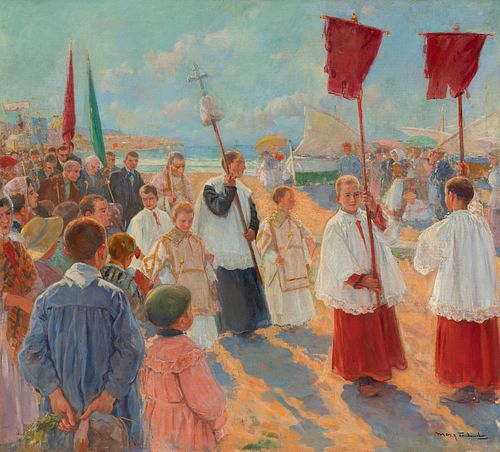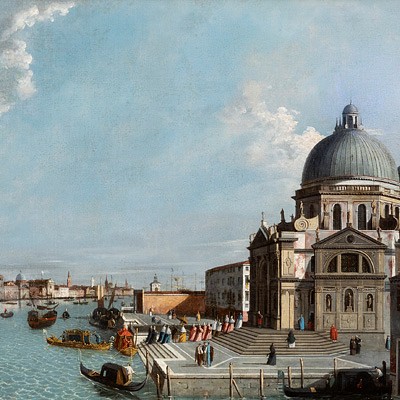ARCADI MAS I FONDEVILA (Barcelona, 1852 - Sitges, Barcelona, 1934). "Procession from the hermitage of Sant Sebastià, Sitges". Oil on canvas. Signed
Lot 17
About Seller
Setdart Auction House
Carrer Aragó 346
Barcelona
Spain
Setdart Subastas was born in 2004 and is currently the first online art auction in Spain with solidity, prestige and reliability guaranteed by our more than 60,000 users. Setdart has a young, dynamic and enterprising team ready to successfully manage the purchase and sale of art works through custom...Read more
Estimate:
EUR€7,000 - EUR€8,000
$7,608.70 - $8,695.65
Absentee vs Live bid
Two ways to bid:
- Leave a max absentee bid and the platform will bid on your behalf up to your maximum bid during the live auction.
- Bid live during the auction and your bids will be submitted real-time to the auctioneer.
Bid Increments
| Price | Bid Increment |
|---|---|
| EUR€0 | EUR€10 |
| EUR€200 | EUR€25 |
| EUR€500 | EUR€50 |
| EUR€1,000 | EUR€100 |
| EUR€3,000 | EUR€200 |
| EUR€5,000 | EUR€500 |
| EUR€10,000 | EUR€1,000 |
| EUR€20,000 | EUR€2,000 |
| EUR€50,000 | EUR€5,000 |
About Auction
By Setdart Auction House
May 18, 2021
Set Reminder
2021-05-18 09:30:00
2021-05-18 09:30:00
America/New_York
Bidsquare
Bidsquare : Classics XIX and XX
https://www.bidsquare.com/auctions/setdart-auction-house/classics-xix-and-xx-6961
The next 18th May there will be a 19th and 20th Century Classics Auction at Setdart.com There will be a select repertoire of important artists such as Carlos Cruz Diez, Luis Feito, Joan Miró, Fernando Botero, Josep Llimona, Salvador Dalí among others. Setdart Auction House sofia@setdart.com
The next 18th May there will be a 19th and 20th Century Classics Auction at Setdart.com There will be a select repertoire of important artists such as Carlos Cruz Diez, Luis Feito, Joan Miró, Fernando Botero, Josep Llimona, Salvador Dalí among others. Setdart Auction House sofia@setdart.com
- Lot Description
ARCADI MAS I FONDEVILA (Barcelona, 1852 - Sitges, Barcelona, 1934). "Procession from the hermitage of Sant Sebastià, Sitges". Oil on canvas. Signed in the lower right corner. Work listed in "Arcadi Mas i Fondevila: the poet painter". Isabel Coll, El Centaure Groc 2014, pg. 304. Measurements: 90 x 100 cm; 113 x 113 cm (frame). In this work, Arcadi Mas has managed to combine a Mediterranean palette with a meticulous sociological observation, extracting from it a juicy and lively popular scene. Painter and draftsman, founder of the luminist school of Sitges, Arcadi Mas i Fondevila was trained at the Escuela de La Lonja in Barcelona, where his teachers were Antonio Caba and Claudio Lorenzale. At the age of twenty he took part in his first collective exhibition, organized in the hall of the Artistic Association of Barcelona. In 1873 he travels to Madrid, visits the Prado Museum and exhibits in the Platería Martínez room a painting that would later be bought by King Alfonso XII. Two years later he won the first Fortuny scholarship from the City Council of Barcelona, which allowed him to further his studies by traveling to Italy as a pensioner between 1876 and 1886. During these years, Arcadi Mas i Fondevila visited Venice, Rome, Naples and Capri, while participating in several group exhibitions at the Sala Parés in Barcelona. Ascribed to the Neapolitan naturalist school of Domenico Morelli, in 1885 he also participated in the exhibition of the Center of Watercolorists of Barcelona. On his return to Catalonia, his friend Joan Roig Soler encouraged him to visit Sitges, and from this meeting and acquaintance was born the luminist school of Sitges, a pictorial current that brought together other artists such as Joaquim de Miró, Antoni Almirall and Joan Batlle. In 1887 he participated in the National Exhibition of Fine Arts in Madrid, and won a medal for his work "Corpus Christi Procession in Sitges". He also participated in the Universal Exposition of Barcelona the following year, being awarded the first medal. In 1895 he travels again to Madrid, this time accompanied by Santiago Rusiñol and Zuloaga, and later he goes to Granada with Rusiñol, Miguel Utrillo and Macari Oller, with the intention of illustrating some articles of the first one for "La Vanguardia". Mas i Fondevila won two more medals at the Fine Arts Exhibitions in Barcelona in 1894 and 1896, and in 1899 he joined the Círculo Artístico de Sant Lluc. In 1900 he inaugurated the Rovira Salon in Barcelona with his first individual exhibition, a show that consecrated him as a master of pastel. An example of the relevance of this painter can be found in the fact that Picasso had copied one of his nudes from 1895. During this period, Mas i Fondevila also collaborated as a draftsman in "La Ilustració Catalana". Thanks to a donation from the American patron Charles Deering, in 1913 he painted the tympanum of the Santa Catalina portal of the church of San Bartolomé and Santa Tecla in Sitges. Today a copy can be admired "in situ", the original having been erased by the passage of time. In 1928 he was commissioned to paint one of the murals of the Sala de Sant Jordi in the Palace of the Generalitat in Barcelona, and in 1932 he exhibited again individually, this time in the Pinacoteca room. On the occasion of the fiftieth anniversary of his death, the Sitgetan Studies Group dedicated an anthological exhibition to him at the Maricel Museum (1985). In his painting, Mas i Fondevila combined Catalan localism with his Neapolitan memories. He also worked on portraits, with outstanding works such as those of Antonio Caba and Pitarra. He is represented in the National Art Museum of Catalonia, the Maricel, the Cau Ferrat and the Sitges Town Hall, as well as in other museums and private collections.
- Shipping Info
-
In-House Shipping
-
- Buyer's Premium



 EUR
EUR CAD
CAD AUD
AUD GBP
GBP MXN
MXN HKD
HKD CNY
CNY MYR
MYR SEK
SEK SGD
SGD CHF
CHF THB
THB

















